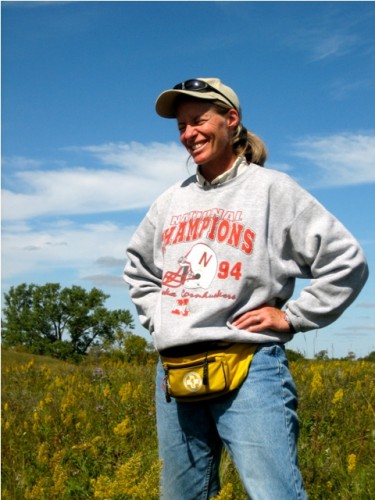 Amy B. Dykstra
Amy B. Dykstra
Department of Biological Sciences
Bethel University
St. Paul, MN 55112
Education
BA, biology, University of Colorado at Colorado Springs
BS, secondary education, University of Wyoming
MS, botany, University of Wyoming
PhD, plant biological sciences, University of Minnesota
I have been involved with the Echinacea project since 2007. As a graduate student in Ruth Shaw‘s research group, I began three long-term studies focused on demography, the effects of inter-population crosses, and local adaptation of fragmented populations of Echinacea angustifolia. Early results of these studies were published in my dissertation; long-term results are still to come.
Demography of remnant Echinacea populations
I constructed matrix population models based on data from Echinacea individuals in 14 prairie remnants to estimate population growth rate (λ). Based on transitions from 2009-2010 and 2010-2011, λ was significantly less than 1, predicting population decline. A matrix model for the 5 largest populations had a significantly higher λ than the matrix model representing the remaining 9 small populations. In our ongoing efforts to understand the population dynamics of Echinacea, we continue to monitor annual seedling recruitment and the survival of the seedlings we have identified since 2007.
Crossing experiment
Small, isolated population remnants may suffer decreased genetic diversity, due to inbreeding and genetic drift. Genetic diversity could be increased by out-crossing to neighboring population remnants; however, interpopulation crosses may also result in outbreeding depression (decreased fitness in the offspring of between-population crosses compared to within-population crosses). To investigate the potential for heterosis (hybrid vigor) vs. outbreeding depression, I (with lots of help from Team Echinacea!) performed within-population and between-population crosses using 6 remnant populations of Echinacea. We sowed the seeds that resulted from these crosses in fall 2008, and have been monitoring survival and growth since 2009. Early results are mixed, with heterosis in one or more traits observed for 3 maternal populations and outbreeding depression observed in one or more traits for 3 populations.
Local adaptation
To investigate local adaptation in Echinacea angustifolia, I collected seeds from three locations along a 500-km transect: Grand River National Grassland south of Lemmon, SD, Samuel H. Ordway, Jr. memorial preserve northwest of Aberdeen, SD, and Staffanson Prairie in Minnesota. I then reciprocally sowed seeds from the three locations in experimental plots near each collection site. Early results show no evidence of local adaptation. Seedling emergence was lowest in the western South Dakota plot and highest in the Minnesota plot for all three source populations. The western South Dakota seedlings had the highest survival and the Minnesota seedlings had the lowest survival at all three experimental plots. I am continuing to collect survival and growth data to see whether evidence of local adaptation emerges at later stages of Echinacea’s life cycle.
The results of my local adaptation experiment suggest that Echinacea seeds collected at a distance could be used successfully in a prairie restoration. However, the mixed results from my crossing experiment suggest that crosses between foreign and local populations could result in offspring with lower fitness than either parental population. I think managers should be cautious about using non-local seed for restoration.
